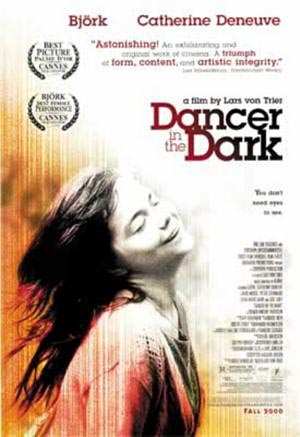Dancer in the Dark
 Lars von Trier's Dancer in the Dark (2000) intersects musical fantasy and stark realism, acting as a vehicle for songwriter Bjork to perfect her idiosyncratic musical and vocal styling onto film, while acting as another female victim story for von Trier, who has now directed four consecutive films that examine community, treachery, and female martyrdom (Breaking the Waves, this, Dogville, and Manderlay). Yet, despite this limiting effect, this is also the fourth consecutive quality work that von Trier has produced.
Lars von Trier's Dancer in the Dark (2000) intersects musical fantasy and stark realism, acting as a vehicle for songwriter Bjork to perfect her idiosyncratic musical and vocal styling onto film, while acting as another female victim story for von Trier, who has now directed four consecutive films that examine community, treachery, and female martyrdom (Breaking the Waves, this, Dogville, and Manderlay). Yet, despite this limiting effect, this is also the fourth consecutive quality work that von Trier has produced.Selma (Bjork) is a Czech factory worker in 1950s America and a lover of American musicals, attending films with her friend and co-worker Kathy (the extraordinary Catherine Deneuve). She continually saves money from her work in an effort to repair her son’s eyesight, which is a hereditary disease that plagues her as well, before he loses his eyesight as she is losing hers. She rents her home from policeman Bill Houston (David Morse), who is emotionally weak and confides to her that his wife’s exorbitant spending has left them penniless, even after he adds together his income with Selma’s rent money. As a result, he steals Selma’s stashed money and eventually forces her to kill him if she wants the money back. Of course, she is caught and tried for murder.
Intercut with the stark realism, Selma escapes into flights of fancy, dreaming up song and dance numbers that echo and romantically comment upon her plight in the real world. These shots, unlike the real world sequences, possess a timeless visual palette, as they differentiate from the more traditional von Trier handheld-camera stylistic. Moreover, the songs are intensely beautiful, full of percussive force and Bjork’s always remarkable voice.
To critique von Trier for historical accuracy, as some detractors are wont to do, is a pointless attack, since he does not really care historical accuracy, but instead values emotional accuracy. And the climax of the film, in the “Next to Last Song” number, is exceedingly powerful and gut-wrenching. Moreover, Bjork displays such a naked portrayal of Selma that any little criticisms dissolve in the face of her martyrdom, as we begin to understand why she sacrifices herself for her son. Indeed, understanding the value of human life and sacrifice is one of the first keys to understanding von Trier’s films. His films work as Christian allegory, as Greg notes, but they work just as well as stories that offer a worth of life that rises far beyond one's own.
Loaded with haunting musical numbers and the expected bullet-to-the-head emotional charge in all of von Trier’s films, Dancer in the Dark is an exceptional film full of dramatic force.
Dancer in the Dark: 8.5/10

0 Comments:
Post a Comment
<< Home